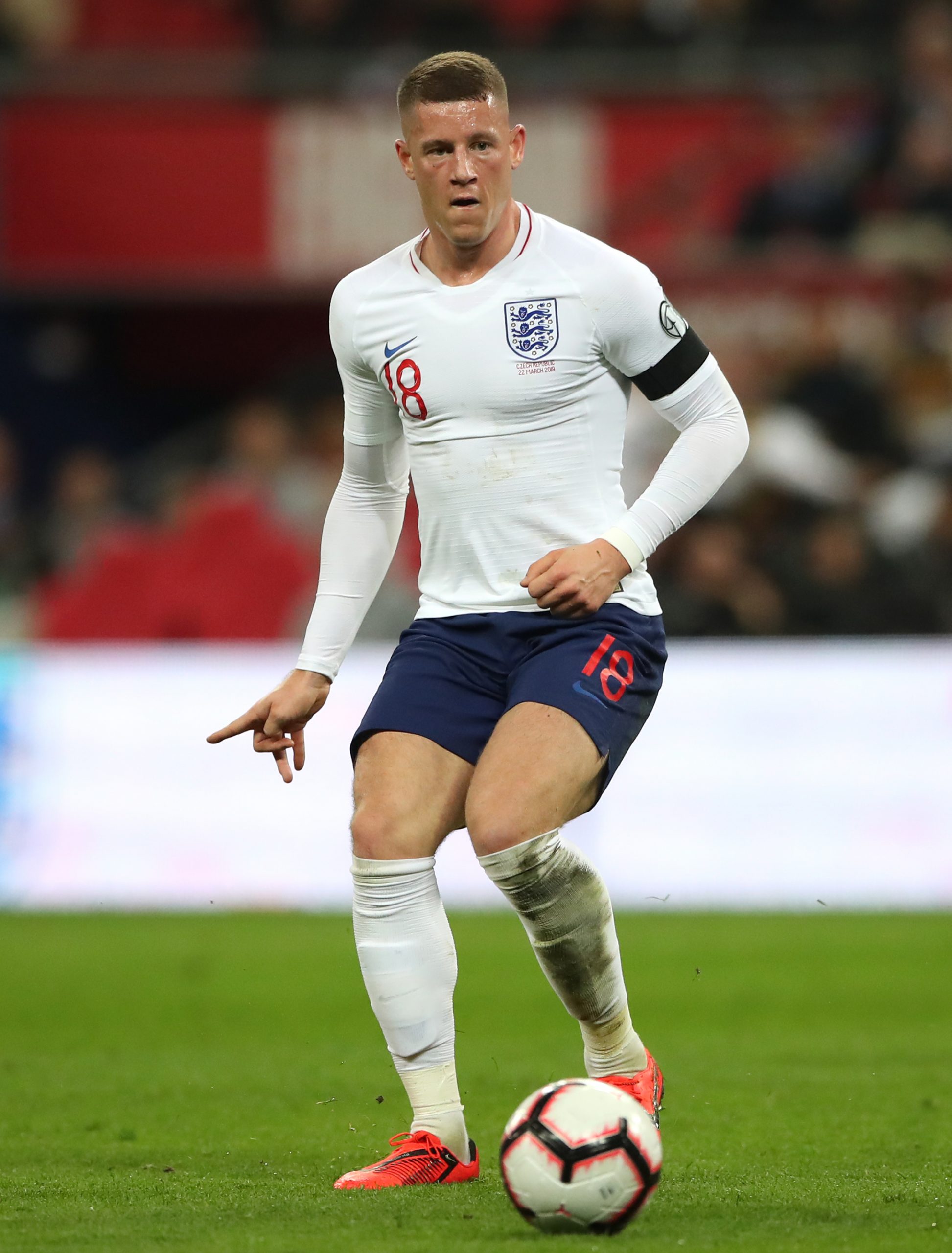Most would agree that Gareth Southgate’s time in charge of England has seen the side improve in a number of ways. The Three Lions’ run to the semi finals of the World Cup was an achievement in finding solutions to clear squad issues, namely a lack of creative passers. The 3-5-2 system Southgate switched to at times seemed primarily about placing more emphasis in possession on the wing backs, as Kieran Trippier was perhaps the only starter who could be considered “creative” (Danny Rose’s poor form was a blow here, as the other wing back role was thus taken by the limited Ashley Young). While Jordan Henderson screened the back three, the more advanced central midfield roles were thus taken by Jesse Lingard and Dele Alli, both of whom are more adept at pressing and making runs into the box than picking out a pass. The result was a resilient side, and England grinded their way through the tournament until meeting an opponent with genuine creative talents. This stylistic choice meant England were somewhat limited in terms of how to attack. Southgate’s men scored twelve goals in the competition. Three were penalties. Four were from corners. One was a direct free kick successfully converted while another came off an indirect free kick routine. Just three were from open play. The FA sacked Sam Allardyce in disgrace nearly two years earlier, but it seemed like that brief spell was enough to implement his attacking ideas. All of this is understandable for a tournament where England had a talented but poorly balanced squad, but the Southgate era is supposed to be about bringing through promising young players and building a more cohesive style of football. Thus it wasn’t a huge shock to see England ditch that system last autumn. It was a shift that many, including StatsBomb’s Paul Riley, had advocated for. The new formation is a fairly conventional 4-3-3 shape. The front line has seen Harry Kane flanked by two wide forwards, initially Raheem Sterling and Marcus Rashford, though Jadon Sancho has deputised in Rashford’s absence. As Kane himself put it, “the wingers stay wide, and then sometimes, when I drop deep, they go in behind”. It’s these moments when Kane has drifted into a deeper role that England have looked particularly dangerous. The first goal against the Czech Republic was a good example of this, with Kane moving deep to pick out Sancho high and wide, who was then able to put in a low cross for Sterling to score the kind of poacher’s finish he’s managed so often at Manchester City. That Kane, obviously a prolific goalscorer at club level, is doing his best work for England outside the box speaks to the composition of the rest of the side. Southgate’s team just doesn’t have anyone who can consistently play penetrative passes from midfield, and thus Kane is dropping deeper to fill some of that role. England started the game with Alli joined by the now infamous pair of Henderson and Eric Dier. In Dier’s case, he generally benefits at Spurs from the better passing ranges of Christian Eriksen and (the unfortunately injured) Harry Winks in that team. Henderson is often a better passer than his reputation suggests, but as the deepest lying midfielder with others having to do the heavy lifting of moving the ball closer to the goal. Here, he was forced to start the game in a more advanced role that he hasn’t played for several years. Not since Jürgen Klopp’s first season at Anfield has he been trusted as anything other than a holding player, and even so, Fabinho has often been preferred this season in part due to his better passing range. A midfield for fluid passing and quick interplay with the forward line, this is not. 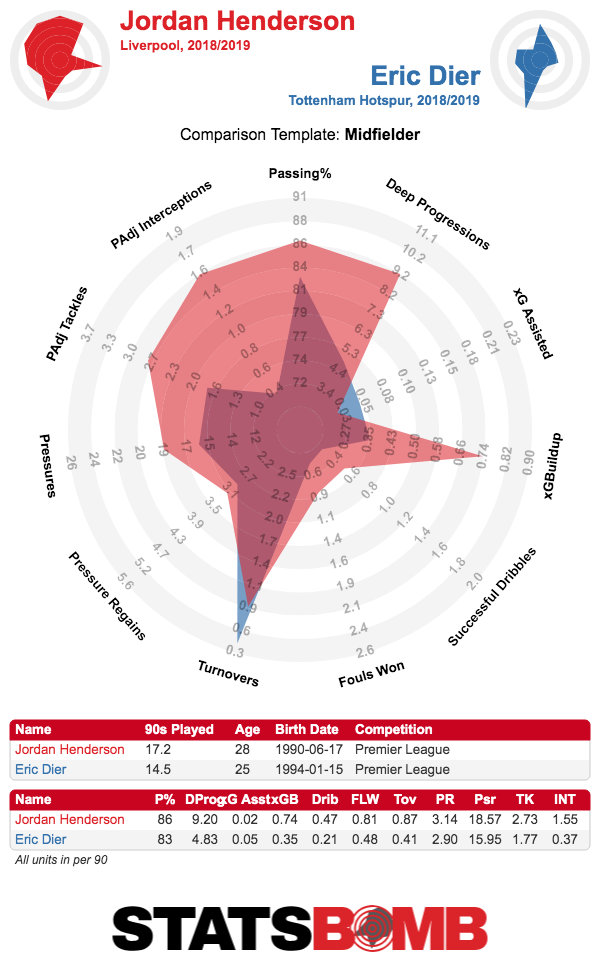 Of course, what happened during the game was that Dier picked up an early injury to be replaced by the more forward thinking Ross Barkley. The idea of Barkley is exactly the player England are lacking. An attack minded midfielder who combines natural athleticism and close control dribbling ability with an excellent eye for a pass in the final third. This is not, however, the reality of the Chelsea midfielder. In fairness, there have been signs of progress this season, with Barkley at least showing he’s capable of being an average contributor at a side challenging for Champions League places, but the traits seen at Everton, around being too dawdling on the ball, too unwilling to appreciate the game taking place around him, remain. Barkley has completed 6.18 deep progressions per 90 this season for Chelsea. Looking at his midfield colleagues, even the supposedly unsuited for possession play N’Golo Kanté has more. He perhaps shouldn’t elicit the groans he once did, but it’s a worrying state if Barkley is to be the solution to England’s problems.
Of course, what happened during the game was that Dier picked up an early injury to be replaced by the more forward thinking Ross Barkley. The idea of Barkley is exactly the player England are lacking. An attack minded midfielder who combines natural athleticism and close control dribbling ability with an excellent eye for a pass in the final third. This is not, however, the reality of the Chelsea midfielder. In fairness, there have been signs of progress this season, with Barkley at least showing he’s capable of being an average contributor at a side challenging for Champions League places, but the traits seen at Everton, around being too dawdling on the ball, too unwilling to appreciate the game taking place around him, remain. Barkley has completed 6.18 deep progressions per 90 this season for Chelsea. Looking at his midfield colleagues, even the supposedly unsuited for possession play N’Golo Kanté has more. He perhaps shouldn’t elicit the groans he once did, but it’s a worrying state if Barkley is to be the solution to England’s problems. 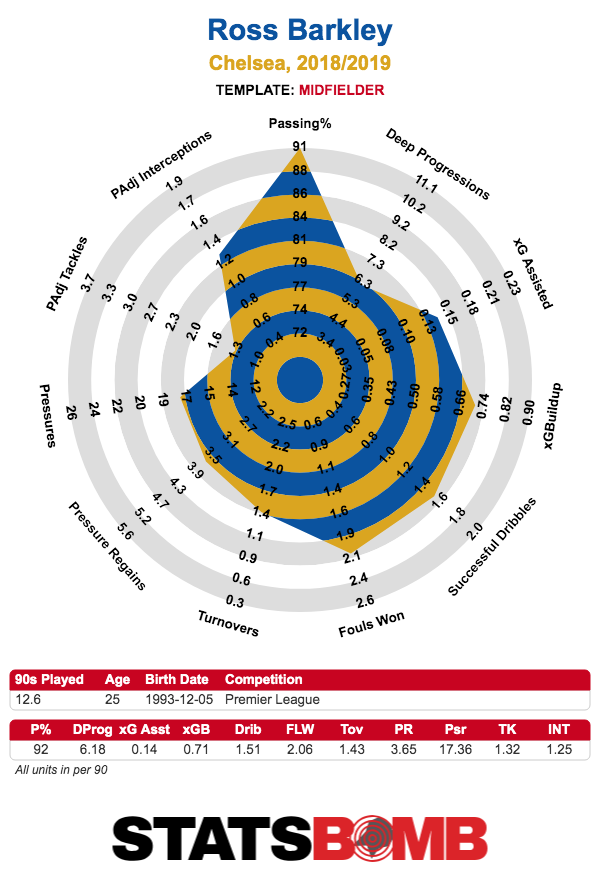 The aforementioned Winks was certainly a loss in this round of fixtures, as his performances in the UEFA Nations League implied he could be an important cog in Southgate’s machine. It’s been something of a strange season for Winks, with Spurs consistent injury problems (and, well, not signing anyone) in midfield have denied him a settled role in his best position. Since the turn of the new year, though, he has hit a strong vein of form in which he’s been able to contribute well on both sides of the ball. Leading Spurs in deep progressions per 90, it looks like Winks could be the player the national side have been lacking, though injury problems seem to be persistent with him.
The aforementioned Winks was certainly a loss in this round of fixtures, as his performances in the UEFA Nations League implied he could be an important cog in Southgate’s machine. It’s been something of a strange season for Winks, with Spurs consistent injury problems (and, well, not signing anyone) in midfield have denied him a settled role in his best position. Since the turn of the new year, though, he has hit a strong vein of form in which he’s been able to contribute well on both sides of the ball. Leading Spurs in deep progressions per 90, it looks like Winks could be the player the national side have been lacking, though injury problems seem to be persistent with him. 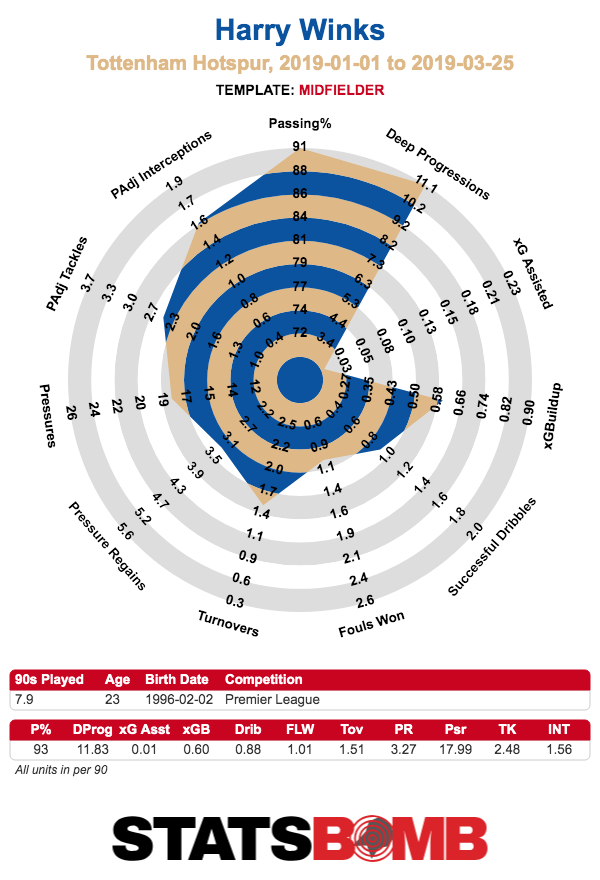 Ruben Loftus-Cheek had to pull out of the squad through injury and almost certainly has the talent to contribute here, but Maurizio Sarri almost never plays him, so it’s hard to get a good read on his level right now. His replacement in the squad, James Ward-Prowse, doesn’t feel like a great fit here. Though an active presser, much of his value comes from being a dead ball specialist, with about half his 0.15 xG assisted per 90 coming from set plays. His deep progressions and open play passes into the box are middle of the road for even lowly Southampton, so his selection here feels like a mistake.
Ruben Loftus-Cheek had to pull out of the squad through injury and almost certainly has the talent to contribute here, but Maurizio Sarri almost never plays him, so it’s hard to get a good read on his level right now. His replacement in the squad, James Ward-Prowse, doesn’t feel like a great fit here. Though an active presser, much of his value comes from being a dead ball specialist, with about half his 0.15 xG assisted per 90 coming from set plays. His deep progressions and open play passes into the box are middle of the road for even lowly Southampton, so his selection here feels like a mistake. 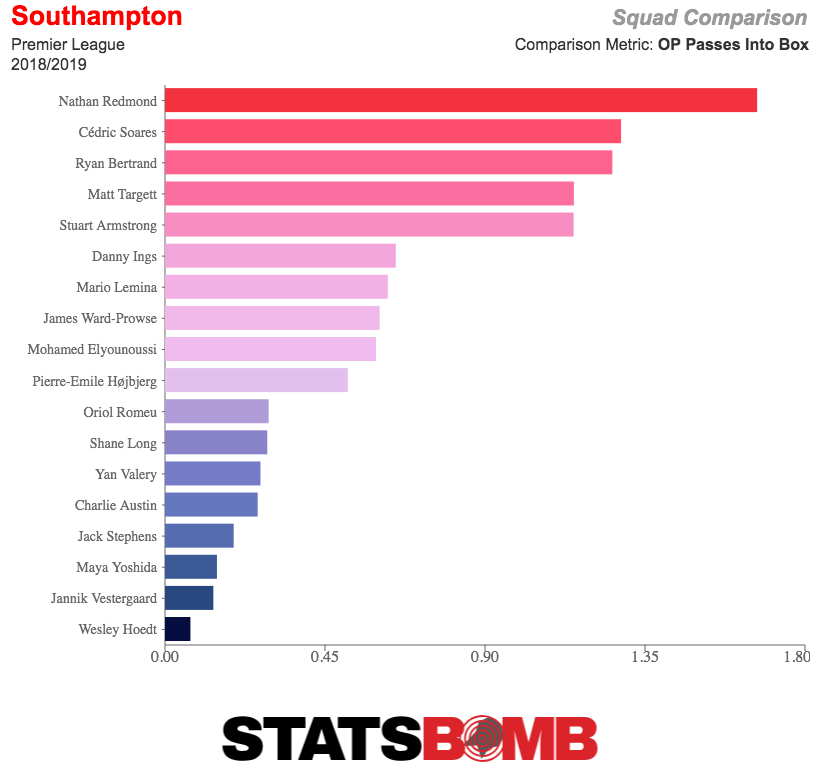 James Maddison, meanwhile, might feel disappointed not to be included. He’s playing open play passes into the box more than twice as frequently as Ward-Prowse, and with similar defensive work to match it up. Having spent all season playing in the attacking midfield band of a 4-2-3-1 for Leicester this season, sliding into a deeper role could be problematic and this seems to be Southgate’s main concern. However, he does seem a player particularly suited to creative passing in the areas where England have not been able to provide it. It would be nice to see him included at some point.
James Maddison, meanwhile, might feel disappointed not to be included. He’s playing open play passes into the box more than twice as frequently as Ward-Prowse, and with similar defensive work to match it up. Having spent all season playing in the attacking midfield band of a 4-2-3-1 for Leicester this season, sliding into a deeper role could be problematic and this seems to be Southgate’s main concern. However, he does seem a player particularly suited to creative passing in the areas where England have not been able to provide it. It would be nice to see him included at some point. 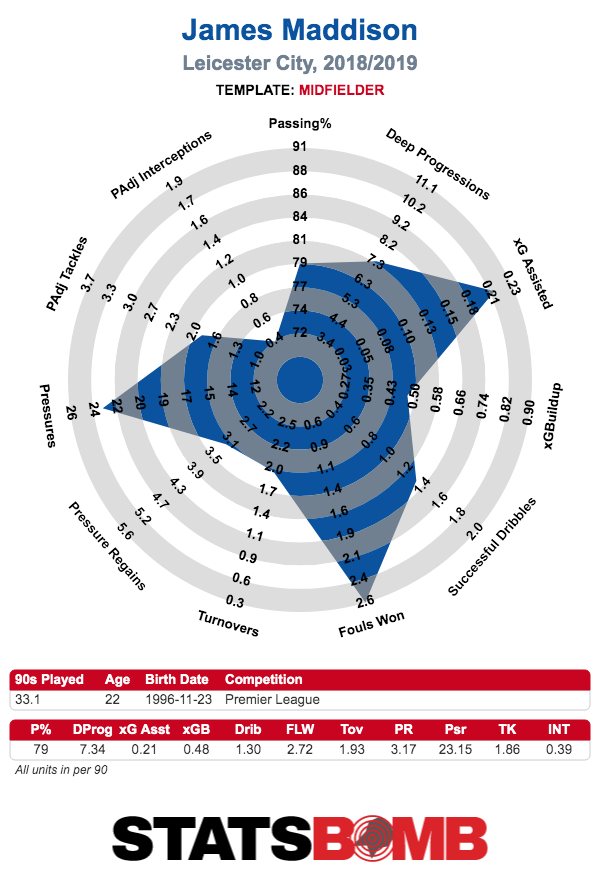 There are some slightly more speculative options out there. Jack Grealish continues to light things up in the Championship, particularly since Dean Smith’s arrival at Villa Park, and has led to many arguing a break from the unwritten rule favouring top flight players. Morgan Gibbs-White has set a promising standard in his first year of senior top flight football, and seems as though he’ll trickle his way up from the youth sides eventually, as does the clearly special but stuck behind the best in the world Phil Foden. Alex Oxlade-Chamberlain’s injury recovery makes him something of an open question, but the form he showed for Liverpool last year should be more than good enough for England. Southgate is having his side play a more cohesive, aesthetically pleasing game since the switch to 4-3-3. It’s not a tiki-taka style, with fast transitions certainly an important feature, but it is one that relies much more on the playmaking abilities of the individuals on the pitch. In the long run, these personnel issues look likely to fix themselves, with the talented younger generations not having this same achilles heel as the 2018 squad. As such, it looks as though Southgate’s tactical switch will pay off in the long term and see an England side playing better football in future tournaments. Header image courtesy of the Press Association
There are some slightly more speculative options out there. Jack Grealish continues to light things up in the Championship, particularly since Dean Smith’s arrival at Villa Park, and has led to many arguing a break from the unwritten rule favouring top flight players. Morgan Gibbs-White has set a promising standard in his first year of senior top flight football, and seems as though he’ll trickle his way up from the youth sides eventually, as does the clearly special but stuck behind the best in the world Phil Foden. Alex Oxlade-Chamberlain’s injury recovery makes him something of an open question, but the form he showed for Liverpool last year should be more than good enough for England. Southgate is having his side play a more cohesive, aesthetically pleasing game since the switch to 4-3-3. It’s not a tiki-taka style, with fast transitions certainly an important feature, but it is one that relies much more on the playmaking abilities of the individuals on the pitch. In the long run, these personnel issues look likely to fix themselves, with the talented younger generations not having this same achilles heel as the 2018 squad. As such, it looks as though Southgate’s tactical switch will pay off in the long term and see an England side playing better football in future tournaments. Header image courtesy of the Press Association
2019
Solving England’s Creativity Issue
By admin
|
March 25, 2019
